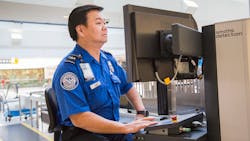TSA asks industry for new airport security enabling technologies for future passenger screening self-check
WASHINGTON – U.S. airport security experts are approaching industry for new ways of enabling airport passengers to screen themselves, similarly to self-checkout at grocery stores, to enhance aviation security, reduce passenger wait times, and improve the passenger experience.
Officials of the U.S. Department of Homeland Security (DHS) in Washington issued a request for information (Passenger_Self_Screening_RFI_2020) last week for the Passenger Self Screening Systems for Aviation Checkpoint project.
DHS officials envision a passenger self-check solution to transform the TSA Pre concept of operations. TSA Pre enables airline passengers to go through an extensive screening process once every five years in exchange for expedited security screening at the airport.
The Passenger Self Screening Systems for Aviation Checkpoint project is part of the DHS Science and Technology Directorate (S&T) Apex Screening at Speed (SaS) program.
Just like self-checkout at grocery stores, self-tagging checked baggage, or ATM machines, many patrons prefer airport security screening that they can complete by themselves, at their own pace, DHS officials explain.
DHS is exploring ideas to bring similar concepts to the passenger screening process by collaborating with passengers and screening authorities to make security lines and X-ray machines a single-step process.
DHS experts also want to enable passengers to receive personalized alarms while they are in the security line to avoid delays from unexpected security machine alarms.
From industry, DHS wants to learn about new technologies to detect weapons and other threats hidden on passengers without today's levels of Transportation Security Officer (TSO) engagement.
Related: Homeland security system for passenger screening uses facial recognition, iris-on-the-move
Experts would like technology solutions that could be deployed together with an X-ray system and an automated screening lane to screen passengers themselves as they remove shoes, laptop computers, cell phones, tablet computers, foods, liquids, and thick books from their baggage.
The goal is to create a passenger-friendly, intuitive screening process while improving security, accelerating passenger throughput, and reducing pat-down rates.
DHS officials are interested in solutions that use the natural motion passenger as he or she moves through the security line to inspect for concealed items and provide near real-time feedback to the passenger if he or she needs to remove additional items.
Related: DHS asks industry for big improvements in X-ray detection of IEDs in airport security
If successful, this kind of self-screening concept initially may be deployed in a TSA Pre environment. Solutions may consider more advanced screening technologies, such as millimeter wave sensors.
Companies interested should email 10-page white papers no later than 4 Dec. 2019 to the DHS's Carolyn Lethert at [email protected]. Email questions or concerns to Carolyn Lethert at [email protected].
More information is online at https://www.fbo.gov/spg/DHS/OCPO/PIADC/Passenger_Self_Screening_RFI_2020/listing.html.

John Keller | Editor-in-Chief
John Keller is the Editor-in-Chief, Military & Aerospace Electronics Magazine--provides extensive coverage and analysis of enabling electronics and optoelectronic technologies in military, space and commercial aviation applications. John has been a member of the Military & Aerospace Electronics staff since 1989 and chief editor since 1995.

